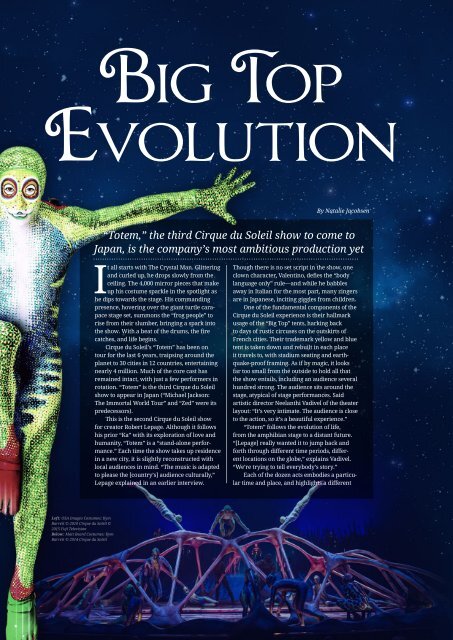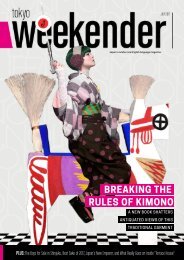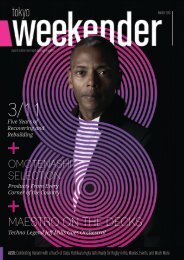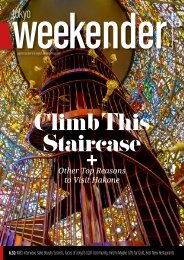Tokyo Weekender - April 2016
Hirotada Ototake- No arms, no legs, no limits. Plus: Natsumi Hoshi Swims for Rio Gold, Getaways for Golden Week, Tokyo Area Guide, The Evolution of Cirque du Soleil, and Much More
Hirotada Ototake- No arms, no legs, no limits. Plus: Natsumi Hoshi Swims for Rio Gold, Getaways for Golden Week, Tokyo Area Guide, The Evolution of Cirque du Soleil, and Much More
You also want an ePaper? Increase the reach of your titles
YUMPU automatically turns print PDFs into web optimized ePapers that Google loves.
By Natalie Jacobsen<br />
“Totem,” the third Cirque du Soleil show to come to<br />
Japan, is the company’s most ambitious production yet<br />
It all starts with The Crystal Man. Glittering<br />
and curled up, he drops slowly from the<br />
ceiling. The 4,000 mirror pieces that make<br />
up his costume sparkle in the spotlight as<br />
he dips towards the stage. His commanding<br />
presence, hovering over the giant turtle carapace<br />
stage set, summons the “frog people” to<br />
rise from their slumber, bringing a spark into<br />
the show. With a beat of the drums, the fire<br />
catches, and life begins.<br />
Cirque du Soleil’s “Totem” has been on<br />
tour for the last 6 years, traipsing around the<br />
planet to 30 cities in 12 countries, entertaining<br />
nearly 4 million. Much of the core cast has<br />
remained intact, with just a few performers in<br />
rotation. “Totem” is the third Cirque du Soleil<br />
show to appear in Japan (“Michael Jackson:<br />
The Immortal World Tour” and “Zed” were its<br />
predecessors).<br />
This is the second Cirque du Soleil show<br />
for creator Robert Lepage. Although it follows<br />
his prior “Ka” with its exploration of love and<br />
humanity, “Totem” is a “stand-alone performance.”<br />
Each time the show takes up residence<br />
in a new city, it is slightly reconstructed with<br />
local audiences in mind. “The music is adapted<br />
to please the [country’s] audience culturally,”<br />
Lepage explained in an earlier interview.<br />
Though there is no set script in the show, one<br />
clown character, Valentino, defies the “body<br />
language only” rule—and while he babbles<br />
away in Italian for the most part, many zingers<br />
are in Japanese, inciting giggles from children.<br />
One of the fundamental components of the<br />
Cirque du Soleil experience is their hallmark<br />
usage of the “Big Top” tents, harking back<br />
to days of rustic circuses on the outskirts of<br />
French cities. Their trademark yellow and blue<br />
tent is taken down and rebuilt in each place<br />
it travels to, with stadium seating and earthquake-proof<br />
framing. As if by magic, it looks<br />
far too small from the outside to hold all that<br />
the show entails, including an audience several<br />
hundred strong. The audience sits around the<br />
stage, atypical of stage performances. Said<br />
artistic director Neelanthi Vadivel of the theater<br />
layout: “It’s very intimate. The audience is close<br />
to the action, so it’s a beautiful experience.”<br />
“Totem” follows the evolution of life,<br />
from the amphibian stage to a distant future.<br />
“[Lepage] really wanted it to jump back and<br />
forth through different time periods, different<br />
locations on the globe,” explains Vadivel.<br />
“We’re trying to tell everybody’s story.”<br />
Each of the dozen acts embodies a particular<br />
time and place, and highlights a different<br />
Left: OSA Images Costumes: Kym<br />
Barrett © 2010 Cirque du Soleil ©<br />
2015 Fuji Television<br />
Below: Matt Beard Costumes: Kym<br />
Barrett © 2014 Cirque du Soleil<br />
APRIL <strong>2016</strong> www.tokyoweekender.com
















